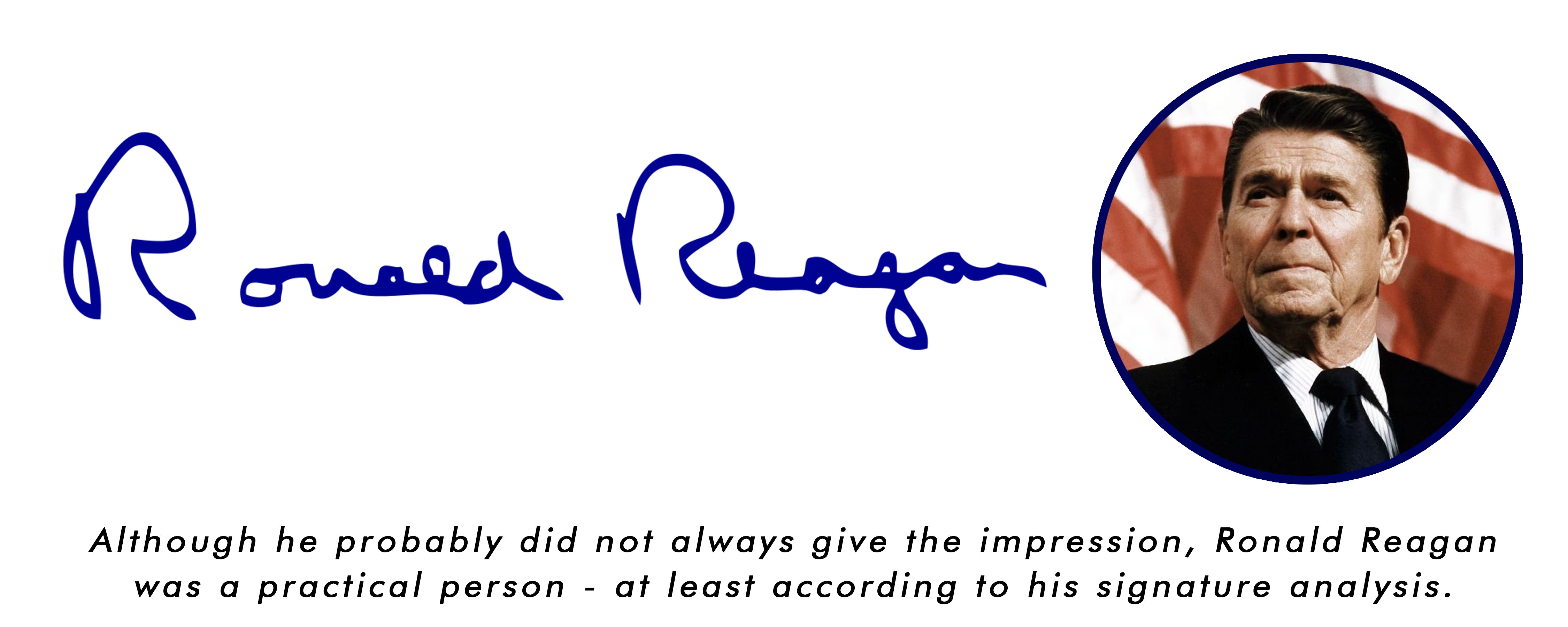Whether on a contract, at the bottom of a letter, or on the back of your bank card, you no doubt use your signature at least semi-frequently. In all likelihood, you probably don’t even give it a second thought — or a first one, for that matter.
For many of us, writing our signature is practically a matter of muscle memory.
But a simple signature is much more than meets the eye. Indeed, how someone chooses to sign their name can tell you a lot about that particular individual and their personality.
- Whether your signature slants upward or downward,
- whether or not it is underlined,
- whether you loop particular letters when signing your name
— all of these things reveal something about you.
In this article, we’ll introduce you to the science of signature analytics, explaining how you can analyze someone’s signature to reveal aspects of their personality.
We’ll also provide you with a few examples of how to put these ideas into practice, walking you through our own analyses of some of the world’s most famous signatures.
So, if you’d like to find out more about the analysis of signature traits and how you can put this knowledge to use yourself, read on! There is much for you to learn.
Are You Supposed to Be Able to Read a Signature?
What Does a Signature Tell You About the Personality of an Individual?
Why Is Your Signature Important?
Examples of Signature Analysis of Famous Personalities
What Is Signature Analysis?
Signature analysis is a specific focus of graphology — a field devoted to analyzing handwriting in order to get a sense of the subject’s personality. This science is based on the idea that our handwriting has thousands of possible traits that reflect aspects of ourselves.
For example, in signature analysis,
- loops,
- the angle of a signature,
- or the number of dots it contains
can reveal particular traits to a keen-eyed signature analyzer. Research conducted in this field also indicates that a person’s signature may be impacted by their age.
The efficacy of this practice has been called into question in the past, but recent studies show that there is merit to it after all. As such, to ensure that you craft a signature that accurately reflects your personality, you would do well to familiarize yourself with the finer points of this fascinating field of study.
What Is the Study of Signatures Called?
While there is no specialist name given to signature analysis, graphology is the name of the field to which it belongs. The two categories that make up this science are:
- Signature analysis
- and handwriting analysis
The practice of analyzing handwriting has ancient roots, but as we know it today, the science was founded in Italy during the early 17th century. Indeed, it wasn’t until the late 19th century, around 1875, that French priest and author Jean-Hyppolyte Michon coined the term “graphology” from the Greek words graph (“I write,” “to write”) and logos (“doctrine,” “theory”).
During the 18th and 19th centuries, graphology only increased in popularity. By the time the early 20th century rolled around, the practice had begun to see commercial use, spurred on by influential European graphologists. Among these practitioners was “the father of modern graphology” himself: one Dr. Eric Singer.
Nowadays, graphology is recognized as being split into two distinct categories: handwriting analysis and signature analysis.
What Is the Difference Between Handwriting Analysis and Signature Analysis?
As you may have pieced together from the names of these two fields of study, the main difference between handwriting analysis and signature reading is that the latter deals specifically with analyzing signatures, as opposed to handwriting more broadly. But what else is there to say about it?
Well, in plain terms, handwriting analysis is best utilized as a tool for estimating someone’s “private persona,” whereas signature analysis can tell you more about their “public persona.”
In other words, your handwriting shows the truth about who you are and can be analyzed to reveal your real feelings and personality. Your signature, on the other hand, shows how you wish to be perceived by others. So, analyzing someone’s signature allows us to see how they want other people to see them.
Are You Supposed to Be Able to Read a Signature?
Generally speaking, you are not supposed to be able to read someone’s signature. This is because they are supposed to be difficult to replicate to prevent signature fraud, as they are most often used as a means of self-identification. That’s why, on most contracts, there will be a space for you to write your name, as well as a space for a signature.
With that being said, whether or not your signature should be easy to read depends on your goals. If you’re not using it for self-identification purposes but rather as part of your brand, then you may wish to opt for a more legible one. So, when coming up with your signature design, you should think carefully about what you’ll be using it for and how this impacts your decisions.
As we’ll discuss later, the legibility of your signature is one of the many traits that can reveal something about your personality to keen-eyed observers.

Why Are Signatures Unreadable?
Signatures are often used to certify important documents. For example, you may use it a signature to:
- Sign a check.
- Sign receipts for bank card payments.
- Sign contracts, e.g., letting contracts, non-disclosure agreements, sales contracts, etc.
- Sign passports and driver’s licenses.
When used as a means of self-identification on such important documents, it’s important that signatures are not only unique but unreadable. This is because they are supposed to be difficult for other people to copy, decreasing the likelihood that ne’er-do-wells will be able to fraudulently sign documents in your name.
When creating your own signature, you should keep all of this in mind. At the same time, avoid signing your name as a scribble on the page. You should be able to recreate your signature with some measure of consistency in order to confirm your identity on important documents.
How to Analyze a Signature
Even the shortest, most basic signature can reveal a lot about someone’s personality. You just need to know what to look for. By keeping your eyes peeled for particular traits and characteristics, you will usually be able to get a fairly accurate idea of what someone is like from their signature alone.
Get your personal handwritten signature logo created by professional calligraphers
OrderBut you don’t need to rely on the fallible human brain alone to attempt to analyze a signature. Existing machine learning technology allows us to scan signatures and recognize image patterns between them, meaning a computer can accurately analyze it in a matter of moments.
In the next section, we’ll explain what the analysis of signatures can reveal about personalities, breaking down a few key traits for your consideration.
What Does a Signature Tell You About the Personality of an Individual?
In graphology, there are over 5,000 identifiable handwriting traits you can use during analysis. Since graphology encompasses both handwriting and signature analysis, not all of these traits will be as useful for signature analysis as they might be for handwriting analysis more generally. Nonetheless, there are still a great number of enlightening features you can look out for.
Below, we’ve covered a few of the most important traits to look out for when analyzing someone’s signature. This is by no means a comprehensive list, but we hope it brings you a step closer to unlocking the secrets of signature and personality analysis.
So, if you’d like to be able to read an individual’s personality with no more than a glance at their signature, read on! This section is bound to be of interest to you.
What Does the Legibility of Your Signature Indicate?
Whether or not your signature is easy to read can indicate a few different things about your personality.
If your signature is clear and legible, it could indicate that you are a straightforward, forthright sort of person. An easy-to-read signature can also be an indicator of confidence and may communicate that you are a balanced individual.
An illegible signature may suggest a lack of transparency on your part. What’s more, difficult-to-read signatures are also often associated with carelessness and arrogance, as they convey the idea that the signee cannot be bothered to pay attention to the details.
On the other hand, an illegible signature might also signal that you are a quick-witted individual, comfortable in your abilities, and unlikely to become weighed down by problems.
What Does Your Pen Pressure Communicate?
According to an article published in the International Research Journal of Engineering and Technology, even the amount of pressure you exert on your pen can convey something about your personality type to the reader.
The research in this paper shows that individuals who only press lightly on the page are better able to cope with traumatic experiences and are less inclined to linger on emotional events.
Additionally, individuals who write with light pen pressure are usually perceived to be less assertive and decisive than those who use heavier pressure.
By contrast, those with heavy pen pressure are more likely to be deep thinkers and highly sensitive individuals. These people may be more affected by emotional or traumatic experiences.
What Does it Mean if Your Signature Slants Upward?
The direction in which your signature slants can convey a few important details about your personality, as well. For example, if it is written at an incline, it may indicate that you are a positive, optimistic individual.
Signatures that slant upward may also show that a person is ambitious and forward-thinking. Thanks to their positive attitude, these people look to the future with a healthy sense of anticipation and excitement, ready to make the most of each new day and every new challenge.
What Does It Mean If Your Signature Slants Downward?
While a signature that slants upward can indicate personality traits such as optimism and ambition, one that slopes downward often conveys the exact opposite. An individual with such a signature is more likely to be cautious and pessimistic and may also struggle with self-esteem problems.
On the whole, you should be wary of using a signature that slopes downwards. You may give someone the impression that you are overly negative or prone to a pessimistic mindset. Therefore it could also reveal when you’re going through a difficult patch in your life.
What Does Underlining Your Signature Mean?
When someone underlines their signature, it sends a clear message: they want to stand out. These individuals are driven by a need for status and recognition, and oftentimes this desire to get noticed results in a bold, daring personality. A simple line beneath your signature can thus demonstrate to someone that you are determined and confident.
What Do Flourishes and Curlicues in Signatures Mean?
Be wary of using such embellishments when signing something. If your line is elaborate, complete with flourishes and curlicues, you could end up coming across as just the opposite of confident. Instead, it may seem like you are trying to get attention to compensate for a lack of self-confidence.

What Do Loops in a Signature Mean?
Including loops in a signature is another way of embellishing it. People who choose this design are thus often perceived as confident, colorful individuals. Loops may also convey a sense of creativity and may indicate that an individual is playful by nature.
On the other hand, some believe that this signature design tells quite a different story. Lower loops, in particular, have often been associated with materiality and a craving for physical pleasures. Using them — especially elaborate, intricate ones — might suggest that you are something of a hedonist.
What Does a Single Dot in a Signature Mean?
While it may appear to be no more than a fleck of ink on the page, a single dot at the end of your signature can add a whole new level of meaning. So, when learning how to analyze signatures, be careful not to overlook this seemingly innocuous addition.
A single dot in a signature generally signals a strong personality. Individuals who include a dot in their signature are often natural leaders. Serious and self-assured, these people are confident in their abilities and are almost always highly motivated.
What Do Two Dots in a Signature Mean?
Some people choose to embellish their signatures with the subtle addition of two dots under it, usually beneath an underline. Though not as flamboyant as some other embellishments some might choose to add, two dots still convey a certain amount of self-assuredness. Those who include this addition most likely possess a healthy ego as well as a desire to stand out and get noticed.
If the dots are accompanied by an underline, pay attention to whether or not it’s at an incline. If so, this may denote positivity and confidence.
Which Type of Signature Is Lucky?
Signature analysis isn’t an exact science. Many traits have multiple meanings, some positive and some negative. As such, it is difficult to identify one foolproof signature style that’s guaranteed to create a good impression.
With that being said, we would recommend the following:
Write your signature on an incline. This can help create the impression that you are a confident, ambitious person, whereas you’ll come across as more negative if your signature slants down.Consider some simple embellishments. Going over the top with flamboyant loops and curlicues can hint at insecurity, but a few well-placed, tasteful embellishments just show off your confidence.
- Make sure your signature is just the right size. If it is too large, you might come across as an egotist. On the other hand, one that’s too small says you’re not confident enough!
Your own professional handwritten signature logo
Get YoursDoes Your Signature Change as You Get Older?
As we get older, we may find it difficult to wield a pen with the dexterity we once had, particularly if disease and ill health are part of the picture. But are there any other reasons why one’s wet signature might change with age?
In short, yes. Older people tend to write more slowly and with less pen pressure. Some will also have a visible tremor in their pen strokes, meaning lines may be slightly wobbly.
Why Is Your Signature Important?
As mentioned previously in this article, your signature shows off your public personality — in other words, the persona you want everybody to see. Whether you sign a card, a contract, or create a logo or line of merchandise with your signature on it, you want to be sure to create a positive impression immediately.
To do that, consider what you convey with your signature. Does the design you’ve chosen show off your best qualities — qualities like confidence, creativity, and optimism? Or does it instead reveal aspects of your personality you may not wish to broadcast, like a lack of self-assuredness or, on the other hand, an inflated sense of self-importance?
By considering the tips in this article, you should find yourself more able to create a signature that shows off the best aspects of your personality. Don’t be afraid to experiment with it! At the end of the day, your main goal should be finding the perfect design for you and your public persona. Especially when it comes down to your brand signature or brand identity design.
Examples of Signature Analysis of Famous Personalities
To conclude, here are a few examples of some signature analysis with examples of well-known celebrities to allow you to see how these lessons can be put into practice. These examples may also give you some ideas when it comes to designing your own signature.
Signatures of famous people are often known as autographs. You may wonder what the difference between signatures and autographs is.
Functionally, they are the same thing, but an autograph specifically refers to a signature from a celebrity—on a headshot, album, or book, for example. A signature tends to refer to when one signs their name on an official document.
Albert Einstein

Quick-witted: While illegibility can imply carelessness in an individual, it can also demonstrate a sharp wit. Surely, if anything can be said of Einstein, it is that his wit was sharp, indeed!Confident: The illegibility of this signature also speaks to an easy-going confidence on behalf of the scientist, as if he scrawled his name without overthinking.
- Forward-looking: Here, we can clearly see that Einstein’s signature slants upwards, which may indicate that he was an optimistic, ambitious person who looked to the future.
Elon Musk

Bold: The illegibility of Musk’s script, as well as the fact he has only included his initials here, demonstrates that he is a confident, bold individual who trusts his signature will at once be known.Motivated: Both initials have long tails that slope upwards, conveying a sense of high motivation and ambition.Optimistic: The sharply sloping tails following each letter also seem to indicate that Musk is an optimistic individual, as they climb up the page rather than turning down.
Prince William

Confident: William’s signature is illegible, which would indicate that the prince is a self-assured individual, comfortable with his place in the public eye.Quick-witted: The illegibility of William’s signature may also show that he is an intelligent man with a sharp wit.Private: Finally, since William’s signature is hard to read, this may convey that he is a private individual — and understandably so, given his position in the limelight.
Michael Jackson

- Hedonistic: The loops and flourishes in Michael Jackson's signature may show indicate that he was someone who had a love for material pleasures.
- Bold: With its impressive verticality and illegibility, this signature also creates an impression of a confident, bold man who was not afraid of taking center stage.
- Playful: The numerous embellishments in this signature indicate that Jackson was a playful individual.
Narendra Modi

Self-assured: The two dots at the end of Narendra Modi’s signature provide some modest embellishment to an otherwise fairly simple signature, creating the impression of self-assuredness.Confident: This signature’s single underline looping back around the “N” further this impression of self-assuredness and seems to demonstrate a confident personality type.Intelligent: Narendra Modi’s signature is simple but elegant but doesn’t clearly show his name. This suggested a quick-witted, intelligent mind.
Vladimir Putin

Confident to arrogant: Putin’s signature is quite difficult to read and has numerous large loops. This may show that he is a confident, if not arrogant, individual.Intelligent: This illegibility also might show that he is an intelligent man, with hard-to-read signatures often indicative of a sharp mind.Secretive: Finally, the fact that this signature is so difficult to make out also creates the impression that Putin is a secretive individual who would rather keep people at arm’s length.
Priyanka Chopra

Confident: The single underline and numerous loops give us the impression that Priyanka Chopra is a confident, bold individual who doesn’t mind standing out from a crowd.Desire for status: The embellishments in this signature may also indicate that the actor has a strong desire to achieve acclaim and high status.Can appear arrogant: Taken together, the underline and loops — in particular, the sizeable loops on the letters “P” and “Y” — show that Priyanka Chopra may seem arrogant rather than merely bold.
Bill Clinton

Balanced: Clinton’s signature is not slanted at all but rather is completely straight, suggesting a balanced outlook on life.Confident: Compared to many of our other examples, this signature is quite easy to read, with each letter clearly distinguishable. This points to a certain confidence in the former president.Pragmatic: This signature is quite plain, and all the letters are clear and evenly spaced, indicating that Clinton is a sensible, practical sort of man.
Mahatma Gandhi

Balanced: This signature neither slants upwards nor downwards but instead is straight, which may demonstrate a balanced approach to life.Pragmatic: The signature is free of ornamentation, as well, revealing an inclination towards pragmatism.Self-assured: Based on this signature, Gandhi seems to be a confident individual, as well, as it is not too difficult to make out and is quite clear on the page.
Ronald Reagan

Confident: Reagan’s signature is easy to make out. This suggests that he was a confident, open person who could make an impression on an audience.Balanced: The horizontal orientation of this signature also indicated a pragmatic, balanced outlook on life.Practical: This signature’s lack of ornamentation and plain lettering backs up this impression of Regan as a practical man.
Abraham Lincoln

Confident: While it’s not immediate when viewing this image in isolation, Lincoln’s signature was slightly bigger than his usual handwriting. This and his clear script give an impression of confidence.Reliable: Lincoln’s handwriting is neat and without ornament, indicating that he was an organized man and, thus, someone you could rely upon.Honest: Lincoln’s signature is clear and legible, creating the impression that he was an honest, straightforward individual—someone you could trust.
Warren Buffet

Self-assured: Buffet’s signature is illegible, which suggests he may be a confident man, sure of himself and his abilities.Practical: At the same time, despite being difficult to read, this signature is free from ornamentation, which might convey that Buffet prefers a realistic, pragmatic approach to things.Balanced: This signature doesn’t have a noticeable slant and is quite straight, which may show that Buffet is logical and balanced in life.
Boris Johnson

Arrogant: The illegibility of this signature, as well as its curling letters and long tail, create an impression of arrogance from Boris Johnson.
- Positive: Johnson’s signature slants upwards, which suggests that he is a positive, optimistic individual who looks to the future.
Desire for status: The long, trailing tail, as well as the curving letters, might indicate that Johnson is a confident person with a desire for status and popularity.
Some other famous characters from whom we have looked at the signatures in detail are:
























Share to: